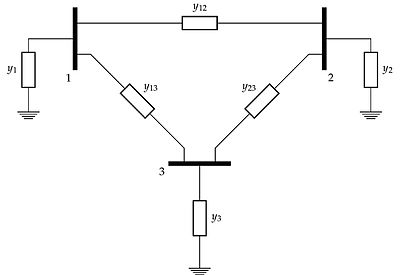In power engineering, nodal admittance matrix (or just admittance matrix) is an N x N matrix describing a linear power system with N buses. It represents the nodal admittance of the buses in a power system. In realistic systems which contain thousands of buses, the admittance matrix is quite sparse. Each bus in a real power system is usually connected to only a few other buses through the transmission lines. The nodal admittance matrix is used in the formulation of the power flow problem.
Construction from a single line diagram
The nodal admittance matrix of a power system is a form of Laplacian matrix of the nodal admittance diagram of the power system, which is derived by the application of Kirchhoff's laws to the admittance diagram of the power system. Starting from the single line diagram of a power system, the nodal admittance diagram is derived by:
- replacing each line in the diagram with its equivalent admittance, and
- converting all voltage sources to their equivalent current source.
Consider an admittance graph with buses. The vector of bus voltages, , is an vector where is the voltage of bus , and vector of bus current injections, , is an vector where is the cumulative current injected at bus by all loads and sources connected to the bus. The admittance between buses and is a complex number , and is the sum of the admittance of all lines connecting busses and . The admittance between the bus and ground is , and is the sum of the admittance of all the loads connected to bus .
Consider the current injection, , into bus . Applying Kirchhoff's current law
where is the current from bus to bus for and is the current from bus to ground through the bus load. Applying Ohm's law to the admittance diagram, the bus voltages and the line and load currents are linked by the relation
Therefore,
This relation can be written succinctly in matrix form using the admittance matrix. The nodal admittance matrix is a matrix such that bus voltage and current injection satisfy Ohm's law
in vector format. The entries of are then determined by the equations for the current injections into buses, resulting in

As an example, consider the admittance diagram of a fully connected three bus network of figure 1. The admittance matrix derived from the three bus network in the figure is:
The diagonal entries are called the self-admittances of the network nodes. The non-diagonal entries are the mutual admittances of the nodes corresponding to the subscripts of the entry. The admittance matrix is typically a symmetric matrix as . However, extensions of the line model may make asymmetrical. For instance, modeling phase-shifting transformers, results in a Hermitian admittance matrix.
Applications
The admittance matrix is most often used in the formulation of the power flow problem.
See also
References
- Grainger, John (1994). Power System Analysis. McGraw-Hill Science/Engineering/Math. ISBN 978-0070612938.
- Saadat, Hadi (1999). "6.7 Tap changing transformers". Power System Analysis. United Kingdom: WCB/McGraw-Hill. ISBN 978-0075616344.
- McCalley, James. "The Power Flow Equations" (PDF). Iowa State Engineering.
- Saadat, Hadi (1999). Power System Analysis. United Kingdom: WCB/McGraw-Hill. ISBN 978-0075616344.
 buses. The vector of bus voltages,
buses. The vector of bus voltages,  , is an
, is an  vector where
vector where  is the voltage of bus
is the voltage of bus  , and vector of bus current injections,
, and vector of bus current injections,  , is an
, is an  is the cumulative current injected at bus
is the cumulative current injected at bus  is a complex number
is a complex number  , and is the sum of the admittance of all lines connecting busses
, and is the sum of the admittance of all lines connecting busses  , and is the sum of the admittance of all the loads connected to bus
, and is the sum of the admittance of all the loads connected to bus 
 is the current from bus
is the current from bus  and
and  is the current from bus
is the current from bus 

 is a
is a  matrix such that bus voltage and current injection satisfy Ohm's law
matrix such that bus voltage and current injection satisfy Ohm's law



 are called the self-admittances of the network nodes. The non-diagonal entries are the mutual admittances of the nodes corresponding to the subscripts of the entry. The admittance matrix
are called the self-admittances of the network nodes. The non-diagonal entries are the mutual admittances of the nodes corresponding to the subscripts of the entry. The admittance matrix  . However, extensions of the line model may make
. However, extensions of the line model may make